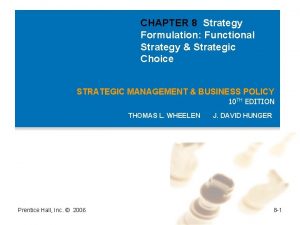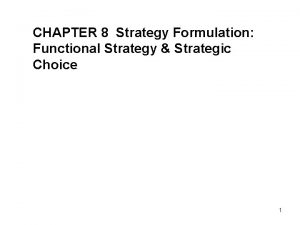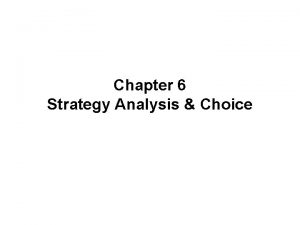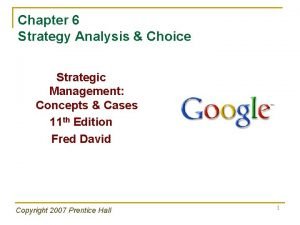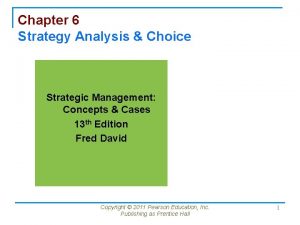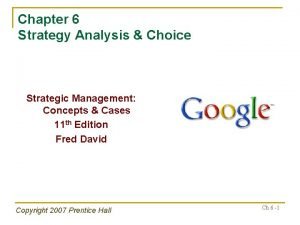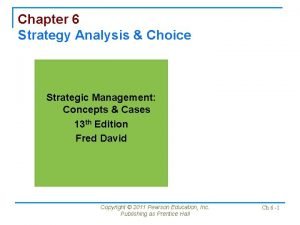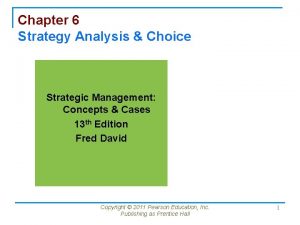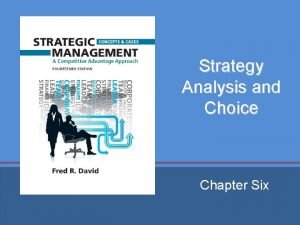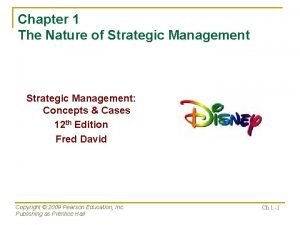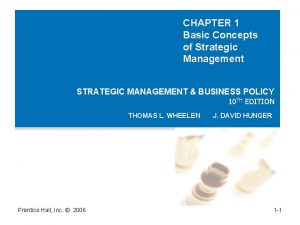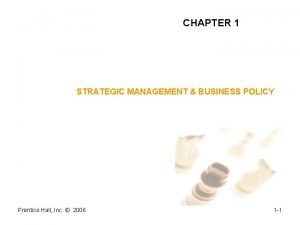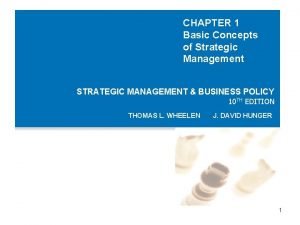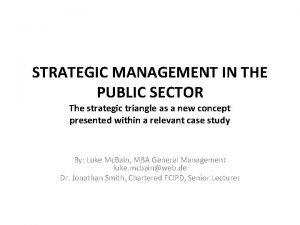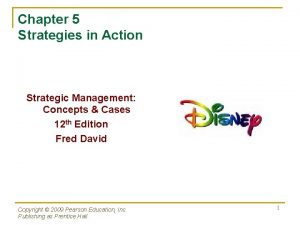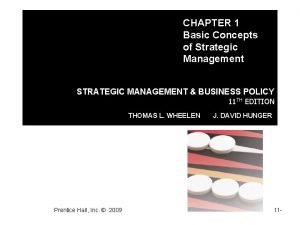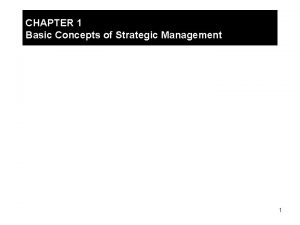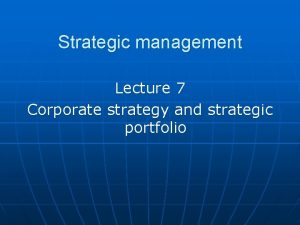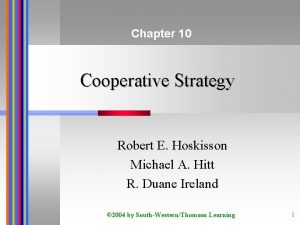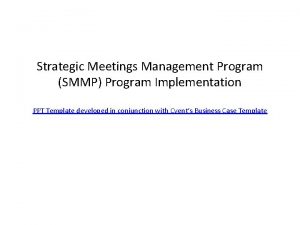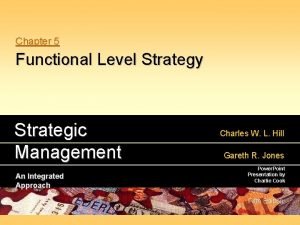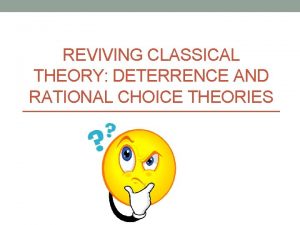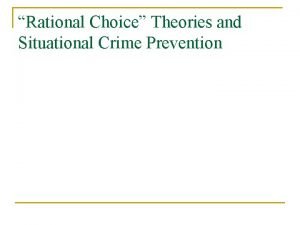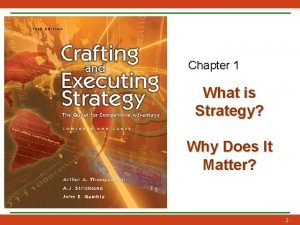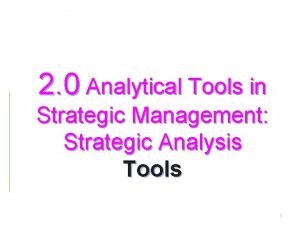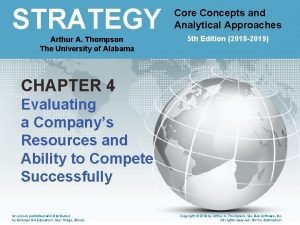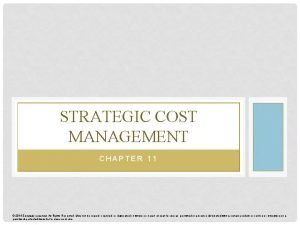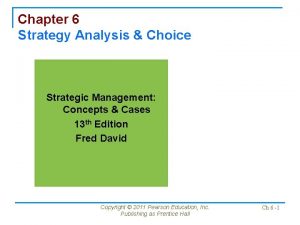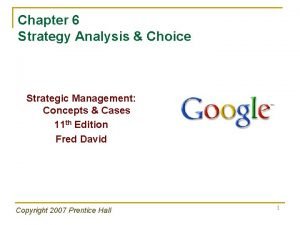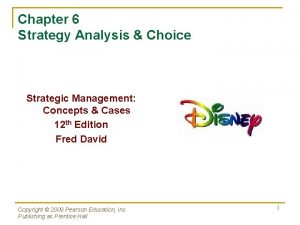Chapter 6 Strategy Analysis Choice Strategic Management Concepts









































- Slides: 41

Chapter 6 Strategy Analysis & Choice Strategic Management: Concepts & Cases 13 th Edition Fred David Copyright © 2011 Pearson Education, Inc. Publishing as Prentice Hall Ch 6 -1

Copyright © 2011 Pearson Education, Inc. Publishing as Prentice Hall Ch 6 -2

Strategy Analysis & Choice n n n Subjective decisions based on objective information Generating alternative strategies Selecting strategies to pursue Best alternative course of action to achieve mission & objectives Derived from vision, mission, objectives, external audit, and internal audit Copyright © 2011 Pearson Education, Inc. Publishing as Prentice Hall Ch 6 -3

Strategy Analysis & Choice Generating Alternatives – Participation in generating alternative strategies should be as broad as possible Copyright © 2011 Pearson Education, Inc. Publishing as Prentice Hall Ch 6 -4

Comprehensive Strategy. Formulation Framework n Stage 1 - Input Stage q q q n Stage 2 - Matching Stage q q q n EFE Matrix IFE matrix CPM SWOT SPACE matrix BCG matrix IE Matrix Grand strategy matrix Stage 3 - Decision Stage q QSPM Copyright © 2011 Pearson Education, Inc. Publishing as Prentice Hall Ch 6 -5

Comprehensive Strategy. Formulation Framework n As shown in the previous Power. Point, strategy formulation techniques can be integrated into a three-stage decision-making framework. The tools presented in this framework are applicable to all sizes and types of organizations and can help strategists identify, evaluate, and select strategies Copyright © 2011 Pearson Education, Inc. Publishing as Prentice Hall Ch 6 -6

The Strategy-Formulation Analytical Framework n n n Stage 1 (Input Stage) summarizes the basic input information needed to formulate strategies. Stage 2 (Matching Stage) focuses on generating feasible alternative strategies by aligning key external and internal factors. Stage 3 (Decision Stage) uses the QSPM to objectively evaluate feasible alternative strategies identified in Stage 2. Copyright © 2011 Pearson Education, Inc. Publishing as Prentice Hall Ch 6 -7

Strategy-Formulation Framework External Factor Evaluation Matrix (EFE) Stage 1: The Input Stage Internal Factor Evaluation Matrix (IFE) Competitive Profile Matrix (CPM) Copyright © 2011 Pearson Education, Inc. Publishing as Prentice Hall Ch 6 -8

Stage 2: The Matching Stage n. Match between organization’s internal resources & skills and the opportunities & risks created by its external factors Copyright © 2011 Pearson Education, Inc. Publishing as Prentice Hall Ch 6 -9

Strategy-Formulation Framework SWOT Matrix SPACE Matrix Stage 2: The Matching Stage BCG Matrix IE Matrix Grand Strategy Matrix Copyright © 2011 Pearson Education, Inc. Publishing as Prentice Hall Ch 6 -10

Stage 2: The Matching Stage SWOT Matrix n. Strengths n. Weaknesses n. Opportunities n. Threats Copyright © 2011 Pearson Education, Inc. Publishing as Prentice Hall Ch 6 -11

SWOT Matrix Four Types of Strategies n. Strengths-Opportunities (SO) n. Weaknesses-Opportunities n. Strengths-Threats (WO) (ST) n. Weaknesses-Threats (WT) Copyright © 2011 Pearson Education, Inc. Publishing as Prentice Hall Ch 6 -12

SWOT Matrix n n SO strategies use a firm’s internal strengths to take advantage of external opportunities WO strategies improve internal weaknesses by taking advantage of external opportunities ST strategies use a firm’s strengths to avoid or reduce the impact of external threats WT strategies defensive tactics aimed at reducing internal weakness and avoiding external threats Copyright © 2011 Pearson Education, Inc. Publishing as Prentice Hall Ch 6 -13

Strategy-Formulation Framework SWOT Matrix SPACE Matrix Stage 2: The Matching Stage BCG Matrix IE Matrix Grand Strategy Matrix Copyright © 2011 Pearson Education, Inc. Publishing as Prentice Hall Ch 6 -14

Strategic Position and Action Evaluation (SPACE) Matrix n The SPACE matrix’s four-quadrant framework indicates whether aggressive, conservative, defensive, or competitive strategies are most appropriate for a given organization. Its axes represent two internal dimensions (financial strength [FS] and competitive advantage [CA]) and two external dimensions (environmental stability [ES] and industry strength [IS]). Copyright © 2011 Pearson Education, Inc. Publishing as Prentice Hall Ch 6 -15

SPACE Matrix n Depending upon the type of organization, numerous variables could make up each of the dimensions represented on the axes of the SPACE matrix. Variables that were included in the firm’s EFE and IFE matrices should be considered in developing a SPACE matrix. Copyright © 2011 Pearson Education, Inc. Publishing as Prentice Hall Ch 6 -16

SPACE Matrix n Internal dimensions q q n Financial strength (FS) Competitive advantage (CA) External dimensions q q Environmental stability (ES) Industry strength (IS) Copyright © 2011 Pearson Education, Inc. Publishing as Prentice Hall Ch 6 -17

Steps to Developing a SPACE Matrix Select a set of variables to define FS, CA, ES, and IS. Assign a numerical value: 1. 2. 1. 2. 3. From +1 to +6 to each FS & IS dimension From -1 to -6 to each ES & CA dimension Compute an average score for each FS, CA, ES, and IS. Copyright © 2011 Pearson Education, Inc. Publishing as Prentice Hall Ch 6 -18

Steps to Developing a SPACE Matrix 4. 5. 6. Plot the average score on the appropriate axis. Add the two scores on the x-axis and plot the point. Add the two scores on the y-axis and plot the point. Plot the intersection of the new xy point. Draw a directional vector from the origin through the new intersection point. This vector reveals the type of strategies recommended for the organization. Copyright © 2011 Pearson Education, Inc. Publishing as Prentice Hall Ch 6 -19

Copyright © 2011 Pearson Education, Inc. Publishing as Prentice Hall Ch 6 -20

Strategy-Formulation Framework SWOT Matrix SPACE Matrix Stage 2: The Matching Stage BCG Matrix IE Matrix Grand Strategy Matrix Copyright © 2011 Pearson Education, Inc. Publishing as Prentice Hall Ch 6 -21

BCG Matrix n The BCG matrix helps multi-divisional firms formulate strategies. It graphically portrays differences among divisions in terms of relative market share position and industry growth rate. Relative market share position is defined as the ratio of a division’s own market share (or revenues) in a particular industry to the market share (or revenues) held by the largest rival firm in that industry. Copyright © 2011 Pearson Education, Inc. Publishing as Prentice Hall Ch 6 -22

BCG Matrix n Relative market share position is given on the x-axis. The mid-point on the x-axis usually is set at. 50, corresponding to a division that has half the market share of the leading firm in the industry. The y-axis represents the industry growth rate in sales, measured in percentage terms. The growth rate percentages on the y-axis could range from 20 to +20%, with 0. 0 being the mid-point. Copyright © 2011 Pearson Education, Inc. Publishing as Prentice Hall Ch 6 -23

BCG Matrix n An example of a BCG matrix appears in the next Power Point. Each circle represents a separate division. The size of the circle corresponds to the proportion of corporate revenue generated by that business unit, and the pie slice indicates the proportion of corporate profits generated by that division. Divisions located in Quadrant I are called “Question Marks; ” Quadrant II, “Stars; ” Quadrant III, “Cash Cows; ” and Quadrant IV, “Dogs. ” Copyright © 2011 Pearson Education, Inc. Publishing as Prentice Hall Ch 6 -24

Copyright © 2011 Pearson Education, Inc. Publishing as Prentice Hall Ch 6 -25

BCG Matrix n n Question Marks – low relative market share in a high-growth industry Stars – high relative market share in a highgrowth industry Cash Cows – high relative market share in a low-growth industry Dogs – Low relative market share in a slow or no growth industry Copyright © 2011 Pearson Education, Inc. Publishing as Prentice Hall Ch 6 -26

Strategy-Formulation Framework SWOT Matrix SPACE Matrix Stage 2: The Matching Stage BCG Matrix IE Matrix Grand Strategy Matrix Copyright © 2011 Pearson Education, Inc. Publishing as Prentice Hall Ch 6 -27

The Internal-External Matrix n n Positions an organization’s various divisions in a nine-cell display Similar to BCG Matrix except the IE Matrix: q q Requires more information about the divisions Strategic implications of each matrix are different Copyright © 2011 Pearson Education, Inc. Publishing as Prentice Hall Ch 6 -28

Copyright © 2011 Pearson Education, Inc. Publishing as Prentice Hall Ch 6 -29

IE Matrix n Based on two key dimensions q q n The IFE total weighted scores on the x-axis The EFE total weighted scores on the y-axis Divided into three major regions q q q Grow and build – Cells I, II, or IV Hold and maintain – Cells III, V, or VII Harvest or divest – Cells VI, VIII, or IX Copyright © 2011 Pearson Education, Inc. Publishing as Prentice Hall Ch 6 -30

Strategy-Formulation Framework SWOT Matrix SPACE Matrix Stage 2: The Matching Stage BCG Matrix IE Matrix Grand Strategy Matrix Copyright © 2011 Pearson Education, Inc. Publishing as Prentice Hall Ch 6 -31

Grand Strategy Matrix Tool formulating alternative strategies n n Based on two dimensions q Competitive position q Market (industry) growth Copyright © 2011 Pearson Education, Inc. Publishing as Prentice Hall Ch 6 -32

RAPID MARKET (INDUSTRY) GROWTH 1. 2. 3. 4. 5. 6. WEAK COMPETITIVE POSITION 1. 2. 3. 4. 5. Quadrant II Market development Market penetration Product development Horizontal integration Divestiture Liquidation 1. 2. 3. 4. 5. 6. 7. Quadrant III Retrenchment Related diversification Unrelated diversification Divestiture Liquidation 1. 2. 3. Quadrant I Market development Market penetration Product development Forward integration Backward integration Horizontal integration Related diversification Quadrant IV Related diversification Unrelated diversification Joint ventures STRONG COMPETITIVE POSITION SLOW MARKET (INDUSTRY) GROWTH Copyright © 2011 Pearson Education, Inc. Publishing as Prentice Hall Ch 6 -33

Strategy-Formulation Analytical Framework Stage 3: The Decision Stage Quantitative Strategic Planning Matrix (QSPM) Copyright © 2011 Pearson Education, Inc. Publishing as Prentice Hall Ch 6 -34

QSPM Quantitative Strategic Planning Matrix n. Technique designed to determine the relative attractiveness of feasible alternative strategies. Copyright © 2011 Pearson Education, Inc. Publishing as Prentice Hall Ch 6 -35

Quantitative Strategic Planning Matrix (QSPM) n n The QSPM is an analytical technique designed to determine the relative attractiveness of feasible alternative strategies. Information from each of the matrices in Stages 1 and 2 is used to construct the QSPM. The left column of a QSPM consists of key internal and external factors (from Stage 1), and the top row consists of feasible alternative strategies (from Stage 2). Specifically, the left column consists of strengths, weaknesses, opportunities, and threats obtained directly from the IFE and EFE matrices. In the column to the right of the key factors, the respective weights received by each factor in the IFE matrix and EFE matrix are recorded. Copyright © 2011 Pearson Education, Inc. Publishing as Prentice Hall Ch 6 -36

Quantitative Strategic Planning Matrix (QSPM) n n The top row of a QSPM consists of alternative strategies derived from each matrix in Stage 2. These matching techniques usually generate similar feasible alternatives. However, not every strategy suggested by the matching techniques has to be evaluated in a QSPM. Strategists should use good intuitive judgment in selecting strategies to include in a QSPM. The basic format of the QSPM is illustrated in the following Power Point. Copyright © 2011 Pearson Education, Inc. Publishing as Prentice Hall Ch 6 -37

Strategic Alternatives QSPM Key External Factors Economy Political/Legal/Governmental Social/Cultural/Demographic/ Environmental Technological Competitive Weight Strategy 1 Strategy 2 Strategy 3 Key Internal Factors Management Marketing Finance/Accounting Production/Operations Research and Development Management Information Systems Copyright © 2011 Pearson Education, Inc. Publishing as Prentice Hall Ch 6 -38

Steps to Develop a QSPM 1. 2. Make a list of the firm’s key external opportunities/threats and internal. strengths/weaknesses in the left column Assign weights to each key external and internal factor. Copyright © 2011 Pearson Education, Inc. Publishing as Prentice Hall Ch 6 -39

Steps to Develop a QSPM 3. 4. 5. 6. Examine the Stage 2 (matching) matrices, and identify alternative strategies that the organization should consider implementing. Determine the Attractiveness Scores. Compute the Total Attractiveness Scores. Compute the Sum Total Attractiveness Score. Copyright © 2011 Pearson Education, Inc. Publishing as Prentice Hall Ch 6 -40

Steps to Develop a QSPM 6. (Continued) Add Total Attractiveness Scores in each strategy column of the QSPM. The Sum Total Attractiveness Scores reveal which strategy is most attractive in each set of alternatives. Higher scores indicate more attractive strategies, considering all the relevant external and internal factors that could affect the strategic decisions. 41
 Strategy analysis and choice largely involves making
Strategy analysis and choice largely involves making Functional strategy
Functional strategy Factors affecting strategic choice
Factors affecting strategic choice Functional strategy and strategic choice
Functional strategy and strategic choice Subjective factors in strategic choice
Subjective factors in strategic choice Chapter 6 strategy analysis and choice
Chapter 6 strategy analysis and choice The nature of strategy analysis and choice
The nature of strategy analysis and choice Chapter 6 strategy analysis and choice
Chapter 6 strategy analysis and choice Chapter 6 strategy analysis and choice
Chapter 6 strategy analysis and choice Chapter 6 strategy analysis and choice
Chapter 6 strategy analysis and choice Strategy analysis and choice
Strategy analysis and choice Ie matrix
Ie matrix Business ethics in strategic management
Business ethics in strategic management Basic concepts of strategic management
Basic concepts of strategic management Basic concepts of strategic management
Basic concepts of strategic management Basic concepts of strategic management
Basic concepts of strategic management Basic concepts of strategic management
Basic concepts of strategic management Public sector strategic management
Public sector strategic management Strategies in action
Strategies in action Strategic management decision making process
Strategic management decision making process A strategic decision is rare, consequential, and directive.
A strategic decision is rare, consequential, and directive. Strategic management and strategic competitiveness
Strategic management and strategic competitiveness Process of crafting and executing strategy
Process of crafting and executing strategy What is corporate strategy in strategic management
What is corporate strategy in strategic management Strategy formulation corporate strategy
Strategy formulation corporate strategy Cooperative strategy in strategic management
Cooperative strategy in strategic management Strategic meetings management strategy
Strategic meetings management strategy Business level strategies
Business level strategies Good choice or bad choice
Good choice or bad choice Deterrence and rational choice theory of crime
Deterrence and rational choice theory of crime Rational choice theory key concepts
Rational choice theory key concepts Process of strategic choice
Process of strategic choice Process of strategic choice
Process of strategic choice Strategic choice approach
Strategic choice approach Jay haley strategic family therapy
Jay haley strategic family therapy Tools for strategic analysis
Tools for strategic analysis Ba 491
Ba 491 Qspm
Qspm Strategic fit vs strategic intent
Strategic fit vs strategic intent Strategic complements and substitutes examples
Strategic complements and substitutes examples Strategy: core concepts and analytical approaches
Strategy: core concepts and analytical approaches Process of strategic cost management
Process of strategic cost management


